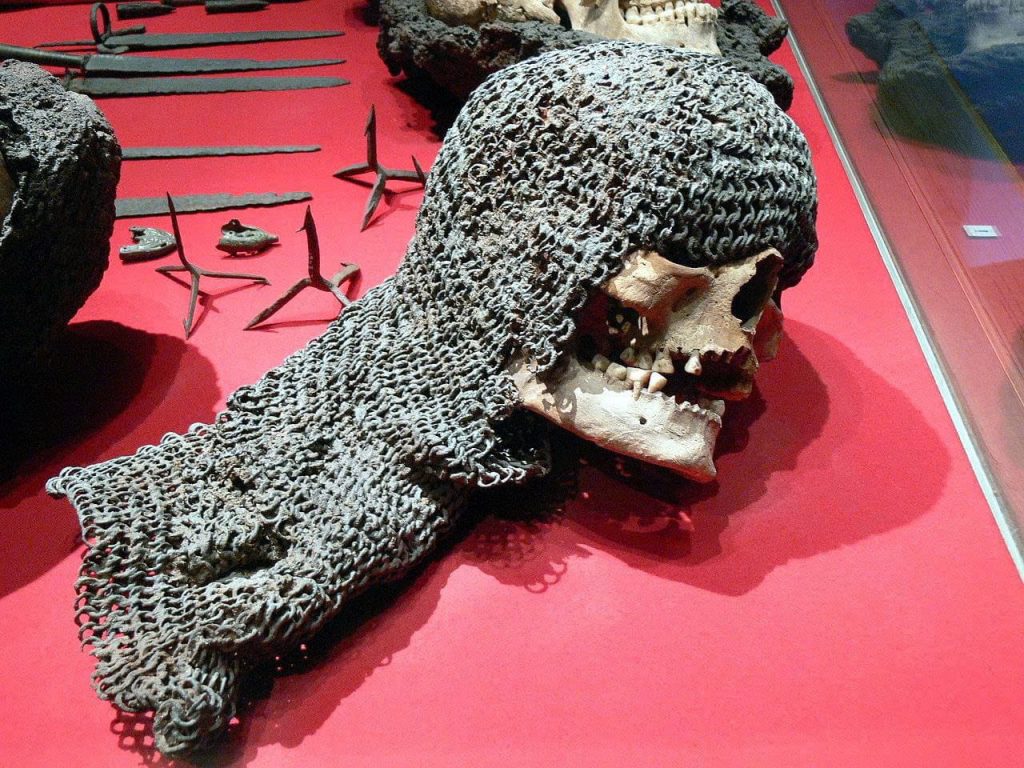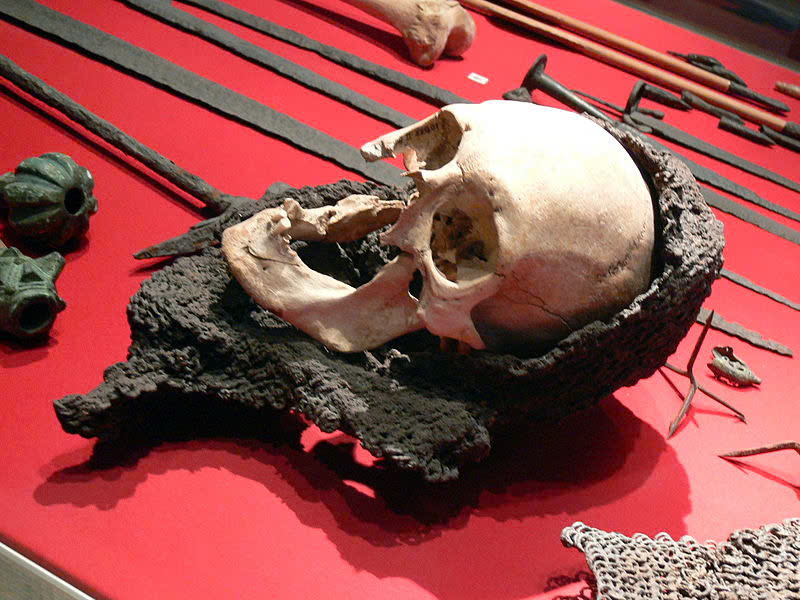In the chronicles of history, few discoveries ignite the imagination as vividly as the skull of a medieval warrior, forever fused with his chainmail armor. This remarkable relic, unearthed from the battlefield of Visby in Sweden, offers a haunting yet poignant window into one of the most significant conflicts of the 14th century.
On the idyllic island of Gotland in 1361, the stage was set for a clash that would leave an indelible mark on medieval Europe. Gotland, with its strategic position in the Baltic Sea, was a valuable asset for the powerful Hanseatic League, a commercial and defensive confederation that dominated trade in Northern Europe. The Danish King, Valdemar Atterdag, keenly aware of its importance, turned his attention to this coveted stronghold. As his fleet appeared on the horizon, the people of Gotland braced themselves for an inevitable confrontation.

The plains outside the walled city of Visby soon erupted in a maelstrom of violence. Danish forces, armed with superior weaponry and clad in formidable armor, advanced upon the defenders of Gotland—a mix of hastily assembled farmers and poorly equipped townsfolk. Steel clashed against steel, the sky darkened with a hail of arrows, and the ground trembled beneath the thunderous charge of mounted knights. Amid this chaos, an unnamed warrior fought valiantly, his chainmail gleaming in the sunlight, a testament to his determination and skill.
As the battle raged, the tide began to turn in favor of the Danish invaders. Overwhelmed by the might and organization of Valdemar’s forces, the defenders of Gotland faltered. In the thick of combat, our unnamed hero faced his final moments. With a resounding crack, an enemy weapon struck true, merging flesh and metal in an instant. His chainmail, designed to protect him, became a grim part of his demise. The defender fell, his sacrifice a silent tribute to the courage of those who stood against overwhelming odds.
Centuries later, the battlefield—long reclaimed by nature—yielded a startling discovery. Archaeologists uncovered a human skull, fused permanently with the remnants of chainmail armor. This macabre relic, a chilling embodiment of the brutality of medieval warfare, brought the past sharply into focus. The find not only provided a tangible connection to the long-forgotten battle but also underscored the ferocity and human cost of medieval conflicts.
The fused skull and armor offer more than a grisly curiosity. They serve as invaluable artifacts for understanding the martial culture of the 14th century. The craftsmanship of the chainmail, the fatal damage to the skull, and the context of the burial provide critical insights into the arms and armor of the time. Such findings reveal details about the technology and tactics employed during the Battle of Visby, shedding light on how warfare shaped the political and social dynamics of Northern Europe.
The Battle of Visby itself was a turning point. King Valdemar’s victory solidified Danish control over Gotland, shifting the balance of power in the Baltic region. Yet, this triumph came at a steep cost. The battlefield became a mass grave, where hundreds of defenders were hastily buried, many still clad in their armor. These remains speak volumes about the harsh realities of medieval combat and the grim aftermath for those who dared to resist.
Reflecting on this soldier’s fate evokes a profound sense of respect for the countless unnamed individuals who shaped history through their courage and sacrifice. Their stories, often lost to time, resonate through the relics they leave behind. The fused remains of this forgotten warrior serve as a timeless reminder of the human spirit’s resilience in the face of insurmountable odds.

The discovery also invites us to consider the broader implications of war and memory. As we analyze this relic, we uncover not only the technical aspects of medieval warfare but also the enduring narratives of bravery and loss. The unnamed soldier’s chainmail, now intertwined with his mortal remains, symbolizes both the protection he sought and the ultimate vulnerability of even the most prepared warrior.
Today, the skull and armor stand as a testament to the enduring legacy of the Battle of Visby. They remind us of the harsh realities faced by those who lived in a time when survival often depended on strength, skill, and sheer determination. These remains, silent witnesses to history, offer an opportunity to honor the sacrifices of the past and to learn from the resilience of those who came before us.
The haunting image of this fused relic—a human skull entangled with chainmail—captures the imagination not only for its striking appearance but also for the depth of history it represents. It serves as a powerful connection to the past, allowing us to glimpse the lives and struggles of individuals who lived centuries ago. Through this discovery, we gain a deeper appreciation for the complexities of medieval life, the art of war, and the enduring human spirit.

In contemplating the story of this unnamed warrior, we are reminded of the importance of preserving and studying such artifacts. They serve as windows into a world vastly different from our own yet fundamentally connected by shared experiences of conflict, survival, and memory. The Battle of Visby, with its tales of valor and tragedy, continues to inspire and educate, offering lessons that transcend time.
As we look upon the fused remains of this medieval soldier, we see more than just the aftermath of a battle. We see a symbol of humanity’s enduring quest for meaning and the sacrifices made in pursuit of a better future. This relic, both haunting and humbling, stands as a testament to the indomitable spirit of those who came before us, ensuring that their legacy endures for generations to come.





